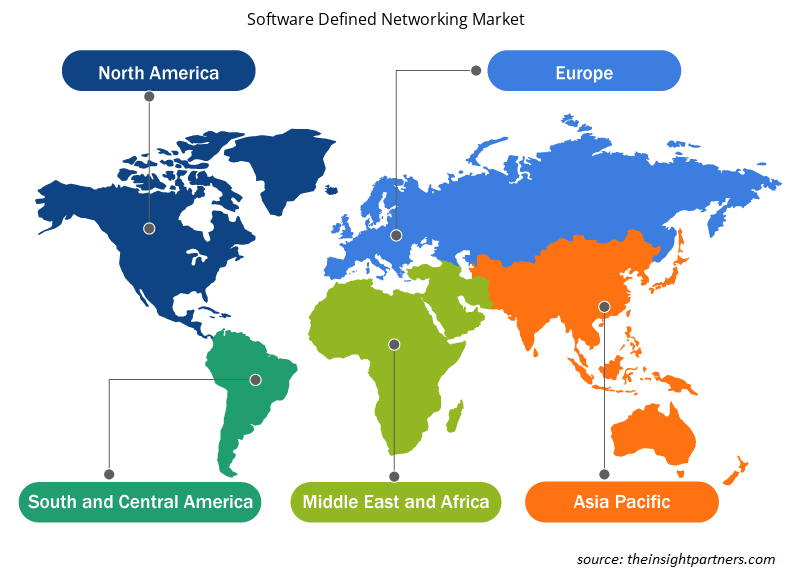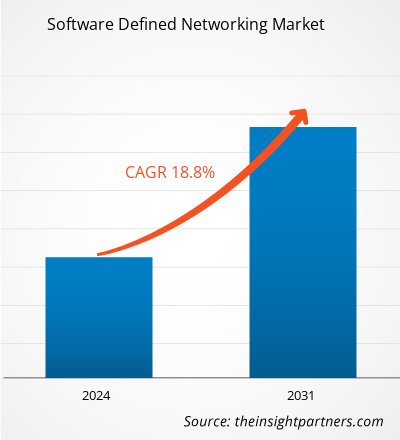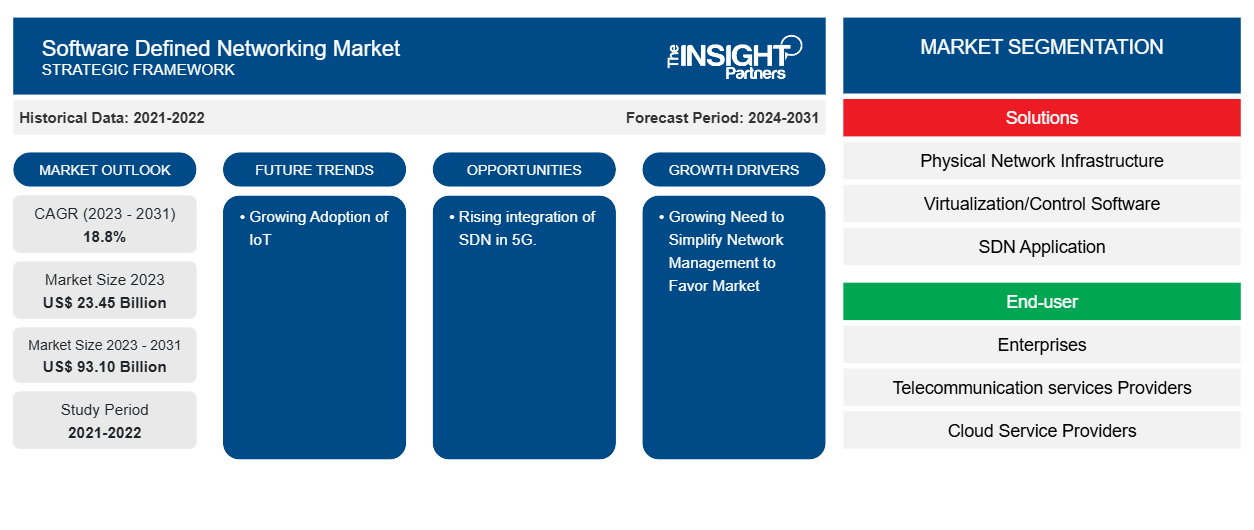Der Markt für softwaredefinierte Netzwerke soll von 23,45 Milliarden US-Dollar im Jahr 2023 auf 93,10 Milliarden US-Dollar im Jahr 2031 anwachsen. Der Markt wird voraussichtlich zwischen 2023 und 2031 eine durchschnittliche jährliche Wachstumsrate (CAGR) von 18,8 % verzeichnen. Der wachsende Bedarf an einer Vereinfachung des Netzwerkmanagements und die zunehmende Implementierung von SDN für 5G werden voraussichtlich weiterhin die wichtigsten Trends auf dem Markt für softwaredefinierte Netzwerke bleiben.
Marktanalyse für softwaredefinierte Netzwerke
Der Markt für softwaredefinierte Netzwerke wächst rasant und treibt das Wachstum des Marktes voran, da IT-Organisationen schnell auf Cloud-Technologie umsteigen. Die IT-Unternehmen und -Einheiten profitieren von den Vorteilen, die mit Rollen und Ereignissen auf Anwendungsebene für funktionale Effizienz und Ausfallsicherheit verbunden sind. Dazu gehören Netzwerkdienstautomatisierung, Cloud-Integration und hybride Automatisierungsdienste. Derzeit generieren mehrere Unternehmen Netzwerkdienstanwendungen für Software für SDN, um einem neuen Standard einen Virtualisierungswert hinzuzufügen, indem diese Dienste die Infrastruktur im Interesse der Anwendungen und ihrer Benutzerfreundlichkeit stark beeinflussen können.
Marktübersicht für Software Defined Networking
Softwaredefiniertes Networking (SDN) ist eine Netzwerktechnik, bei der softwarebasierte Controller oder Anwendungsprogrammierschnittstellen (APIs) verwendet werden, um eine Verbindung mit der zugrunde liegenden Hardwareinfrastruktur herzustellen und den Datenverkehr in einem Netzwerk zu verwalten. Dieser Ansatz unterscheidet sich von herkömmlichen Netzwerken, die den Netzwerkverkehr mit speziellen Hardwarekomponenten wie Switches und Routern verwalten. SDN kann Software verwenden, um ein virtuelles Netzwerk aufzubauen und zu verwalten oder konventionelle Hardware zu verwalten.
Passen Sie diesen Bericht Ihren Anforderungen an
Sie erhalten kostenlose Anpassungen an jedem Bericht, einschließlich Teilen dieses Berichts oder einer Analyse auf Länderebene, eines Excel-Datenpakets sowie tolle Angebote und Rabatte für Start-ups und Universitäten.
-
Holen Sie sich die wichtigsten Markttrends aus diesem Bericht.Dieses KOSTENLOSE Beispiel umfasst eine Datenanalyse von Markttrends bis hin zu Schätzungen und Prognosen.
Treiber und Chancen auf dem Markt für softwaredefinierte Netzwerke
Wachsender Bedarf an einfacherer Netzwerkverwaltung zur Förderung des Marktes
Einer der Hauptfaktoren, die die Branche der softwaredefinierten Netzwerke (SDN) vorantreiben, ist der zunehmende Bedarf von Unternehmen, die Netzwerkverwaltung zu rationalisieren. Herkömmliche Netzwerke verfügen häufig über komplizierte Setups und manuelle Verwaltungsverfahren, was die Kosten erhöht und zu Ineffizienzen führt. SDN bietet eine konsistente Schnittstelle zur Steuerung einer Vielzahl von Netzwerkgeräten, zentralisiert die Netzwerksteuerung und ermöglicht Automatisierung, um diese Schwierigkeiten zu überwinden. Diese zentralisierte Methode erleichtert einen anbieterneutralen Ansatz, beschleunigt die Netzwerkbereitstellung, vereinfacht die Richtlinienverwaltung und verbessert die Transparenz der Netzwerkleistung. SDN ist eine starke Option für die Aktualisierung von Netzwerkinfrastrukturen und die Anpassung an sich ändernde Geschäftsanforderungen, da es den Betrieb vereinfacht, was Unternehmen Geld, Zeit und Ressourcen spart.
Zunehmende Integration von SDN in 5G.
SDN ist eine intelligente Netzwerkarchitektur, die den Standards des 5G-Ökosystems entspricht. 5G kann mithilfe von SDN über eine Steuerungsebene betrieben werden, die ein komplettes Framework bieten kann. Bessere Datenflüsse bei der Datenübertragung über das is an intelligent network architecture that complies with 5G ecosystem standards. 5G can operate over a control plane with the help of 5G-Netzwerk sind nur einer der vielen Vorteile, die diese Technologie bietet. Die SDN-Architektur reduziert die Latenz und maximiert die Netzwerkbandbreite. Durch die Identifizierung der besten Datenflüsse in Echtzeit kann die SDN-Technologie die Netzwerkredundanz von einer zentralen Steuerungsebene aus automatisieren und verwalten und so erhebliche Ausfälle vermeiden.SDN, which can offer an entire framework. Better data flows when data travels across the SDN architecture reduces latency and maximizes network bandwidth. By identifying the best data flows in real-time, SDN technology can automate and manage network redundancy from a centralized control plane, avoiding significant outages.
Marktbericht zu softwaredefinierten Netzwerken – Segmentierungsanalyse
Wichtige Segmente, die zur Ableitung der Marktanalyse für softwaredefinierte Netzwerke beigetragen haben, sind Lösungen, Endbenutzer, Bereitstellung und vertikale Branche.
- Basierend auf Lösungen ist der Markt für softwaredefinierte Netzwerke in physische Netzwerkinfrastruktur, Virtualisierungs-/Steuerungssoftware, SDN-Anwendungen und professionelle Dienste unterteilt.SDN applications, and professional services.
- Nach Endbenutzer ist der Markt in Unternehmen, Telekommunikationsdienstleister und Cloud-Dienstanbieter segmentiert.
- Basierend auf der Branchenverteilung ist der Markt für softwaredefinierte Netzwerke in die Bereiche Bank- und Finanzdienstleistungen und Versicherungen, Telekommunikation und IT, Konsumgüter und Einzelhandel, Regierung und Verteidigung, Fertigung, Forschung und Wissenschaft und Sonstige unterteilt.
Softwaredefinierte Netzwerk-Marktanteilsanalyse nach geografischer Lage
Der geografische Umfang des Berichts zum Markt für softwaredefinierte Netzwerke ist hauptsächlich in fünf Regionen unterteilt: Nordamerika, Asien-Pazifik, Europa, Naher Osten und Afrika sowie Südamerika/Süd- und Mittelamerika. Nordamerika hat den Markt für softwaredefinierte Netzwerke dominiert. Die Trends zur Einführung hoher Technologien in verschiedenen Branchen in der nordamerikanischen Region haben das Wachstum des Marktes für softwaredefinierte Netzwerke vorangetrieben. Faktoren wie die zunehmende Einführung digitaler Tools und hohe Technologieausgaben von Regierungsbehörden dürften das Wachstum des nordamerikanischen Marktes für softwaredefinierte Netzwerke vorantreiben. Darüber hinaus zwingt eine starke Betonung von Forschung und Entwicklung in den entwickelten Volkswirtschaften der USA und Kanadas die nordamerikanischen Akteure dazu, technologisch fortschrittliche Lösungen auf den Markt zu bringen. Darüber hinaus gibt es in den USA eine große Anzahl von Akteuren auf dem Markt für softwaredefinierte Netzwerke, die sich zunehmend auf die Entwicklung innovativer Lösungen konzentrieren. Einige der wichtigsten Akteure auf dem Markt für softwaredefinierte Netzwerke sind unter anderem IBM, Cisco und Microsoft. All diese Faktoren tragen zum Wachstum des Marktes für softwaredefinierte Netzwerke in der Region bei.
Regionale Einblicke in den Markt für softwaredefinierte Netzwerke
Die regionalen Trends und Faktoren, die den Markt für softwaredefinierte Netzwerke im Prognosezeitraum beeinflussen, wurden von den Analysten von Insight Partners ausführlich erläutert. In diesem Abschnitt werden auch die Marktsegmente und die Geografie für softwaredefinierte Netzwerke in Nordamerika, Europa, im asiatisch-pazifischen Raum, im Nahen Osten und Afrika sowie in Süd- und Mittelamerika erörtert.

- Holen Sie sich die regionalen Daten für den Markt für softwaredefinierte Netzwerke
Umfang des Marktberichts zu softwaredefinierten Netzwerken
| Berichtsattribut | Details |
|---|---|
| Marktgröße im Jahr 2023 | 23,45 Milliarden US-Dollar |
| Marktgröße bis 2031 | 93,10 Milliarden US-Dollar |
| Globale CAGR (2023 - 2031) | 18,8 % |
| Historische Daten | 2021-2022 |
| Prognosezeitraum | 2024–2031 |
| Abgedeckte Segmente |
Nach Lösungen
|
| Abgedeckte Regionen und Länder |
Nordamerika
|
| Marktführer und wichtige Unternehmensprofile |
|
Dichte der Marktteilnehmer für Software Defined Networking: Die Auswirkungen auf die Geschäftsdynamik verstehen
Der Markt für Software Defined Networking wächst rasant. Die Nachfrage der Endnutzer steigt aufgrund von Faktoren wie sich entwickelnden Verbraucherpräferenzen, technologischen Fortschritten und einem größeren Bewusstsein für die Vorteile des Produkts. Mit der steigenden Nachfrage erweitern Unternehmen ihr Angebot, entwickeln Innovationen, um die Bedürfnisse der Verbraucher zu erfüllen, und nutzen neue Trends, was das Marktwachstum weiter ankurbelt.
Die Marktteilnehmerdichte bezieht sich auf die Verteilung von Firmen oder Unternehmen, die in einem bestimmten Markt oder einer bestimmten Branche tätig sind. Sie gibt an, wie viele Wettbewerber (Marktteilnehmer) in einem bestimmten Marktraum im Verhältnis zu seiner Größe oder seinem gesamten Marktwert präsent sind.
Die wichtigsten Unternehmen auf dem Markt für softwaredefinierte Netzwerke sind:
- Cisco Systems, Inc.
- IBM
- Hewlett Packard Enterprise Development LP
- Broadcom
- Juniper Networks, Inc.
- Huawei Technologies Co., Ltd.
Haftungsausschluss : Die oben aufgeführten Unternehmen sind nicht in einer bestimmten Reihenfolge aufgeführt.

- Überblick über die wichtigsten Akteure auf dem Markt für softwaredefinierte Netzwerke
Neuigkeiten und aktuelle Entwicklungen zum Markt für softwaredefinierte Netzwerke
Der Markt für softwaredefinierte Netzwerke wird durch die Erhebung qualitativer und quantitativer Daten nach Primär- und Sekundärforschung bewertet, die wichtige Unternehmensveröffentlichungen, Verbandsdaten und Datenbanken umfasst. Im Folgenden finden Sie eine Liste der Entwicklungen auf dem Markt:
- Im November 2023 kündigte VMware, Inc. neue Lösungen und erweiterte Partnerschaften an, um Kunden dabei zu helfen, ihre digitale Transformation am Edge zu beschleunigen. Aufbauend auf dem kürzlich eingeführten VMware Software-Defined Edge werden diese Innovationen und neuen Integrationen Kunden dabei helfen, ihre Edge-Umgebungen zu vereinfachen, besser zu sichern und zu modernisieren.
(Quelle: VMware, Inc., Pressemitteilung, 2023)
- Im Februar 2023 kündigte die ETSI Open Source Group TeraFlowSDN die 2. Version des TeraFlowSDN-Controllers an, einem innovativen und robusten SDN-Orchestrator und -Controller. TeraFlowSDN Released 2 bietet erweiterte und validierte Unterstützung für End-to-End-Transportnetzwerk-Slicing über mehrere Netzwerkdomänen hinweg. Diese Version vervollständigt die SDN-Orchestrierung für L2/L3VPN-Bereitstellung, Mikrowellennetzwerke, Point-to-Multipoint-Integration von optischen XR-Transceivern und die Interaktion mit optischen SDN-Controllern über die Transport-API (TAPI) der Open Networking Foundation (ONF).
(Quelle: ETSI, Pressemitteilung, 2022)
Marktbericht zu softwaredefinierten Netzwerken – Umfang und Ergebnisse
Der Bericht „Marktgröße und Prognose für Software Defined Networking (2021–2031)“ bietet eine detaillierte Analyse des Marktes, die die folgenden Bereiche abdeckt:
- Marktgröße und Prognose auf globaler, regionaler und Länderebene für alle wichtigen Marktsegmente, die im Rahmen des Projekts abgedeckt sind
- Marktdynamik wie Treiber, Beschränkungen und wichtige Chancen
- Wichtige Zukunftstrends
- Detaillierte PEST/Porters Five Forces- und SWOT-Analyse
- Globale und regionale Marktanalyse mit wichtigen Markttrends, wichtigen Akteuren, Vorschriften und aktuellen Marktentwicklungen
- Branchenlandschaft und Wettbewerbsanalyse, einschließlich Marktkonzentration, Heatmap-Analyse, prominenten Akteuren und aktuellen Entwicklungen
- Detaillierte Firmenprofile
- Historische Analyse (2 Jahre), Basisjahr, Prognose (7 Jahre) mit CAGR
- PEST- und SWOT-Analyse
- Marktgröße Wert/Volumen – Global, Regional, Land
- Branchen- und Wettbewerbslandschaft
- Excel-Datensatz
Aktuelle Berichte
Verwandte Berichte
Erfahrungsberichte
Grund zum Kauf
- Fundierte Entscheidungsfindung
- Marktdynamik verstehen
- Wettbewerbsanalyse
- Kundeneinblicke
- Marktprognosen
- Risikominimierung
- Strategische Planung
- Investitionsbegründung
- Identifizierung neuer Märkte
- Verbesserung von Marketingstrategien
- Steigerung der Betriebseffizienz
- Anpassung an regulatorische Trends























 Kostenlose Probe anfordern für - Markt für softwaredefinierte Netzwerke
Kostenlose Probe anfordern für - Markt für softwaredefinierte Netzwerke